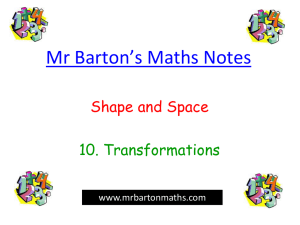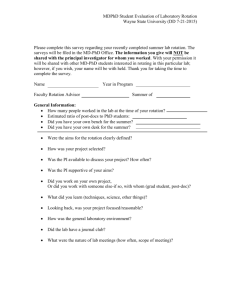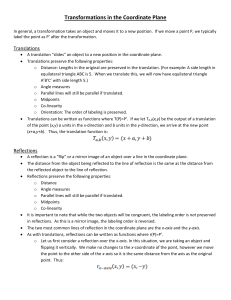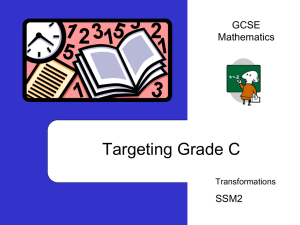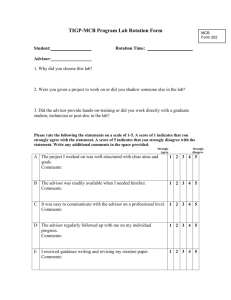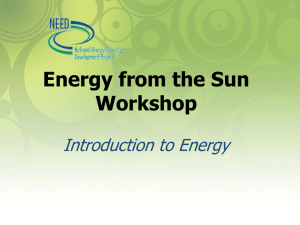1325518361
advertisement
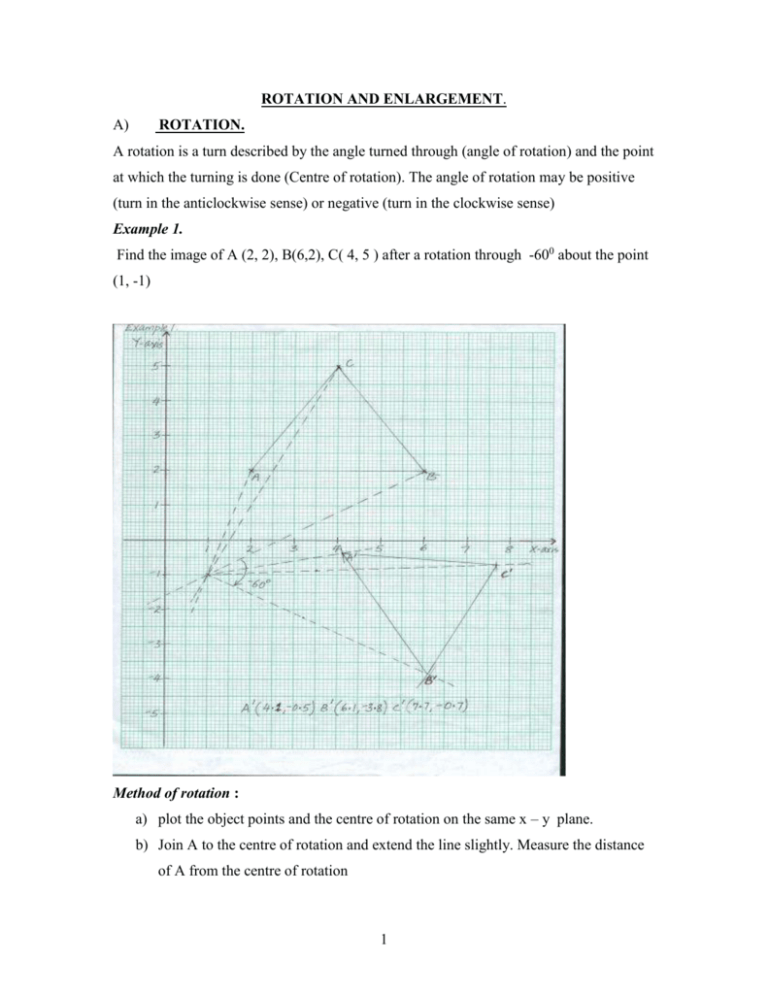
ROTATION AND ENLARGEMENT. A) ROTATION. A rotation is a turn described by the angle turned through (angle of rotation) and the point at which the turning is done (Centre of rotation). The angle of rotation may be positive (turn in the anticlockwise sense) or negative (turn in the clockwise sense) Example 1. Find the image of A (2, 2), B(6,2), C( 4, 5 ) after a rotation through -600 about the point (1, -1) Method of rotation : a) plot the object points and the centre of rotation on the same x – y plane. b) Join A to the centre of rotation and extend the line slightly. Measure the distance of A from the centre of rotation 1 c) Place your protractor at the centre of rotation along this line running from A to the centre so as to measure the required angle (take note of the positioning of the protractor to be able to measure positive and negative angles) d) Measure the angle and remove the protractor. Trace out the line showing the measured angle. (This is the image line). e) Measure off the same distance as that of the object from the centre, along the image line. (Using a compass, place it at the centre and stretch it’s radius up to the object. Turn the compass without lifting it off the centre and cut off the same radius along the image line).This will be the image point. f) Repeat (b) to (e) for all the other points. Example 2. Finding the centre and angle of rotation. The image of the square A( 2,1) B(4,1) C(4,3) D(2,3), after a rotation is A’ (-2,-2) B’(-2,1) C’(-4,1) D’ (-4,-1).Find the centre and angle of rotation. (Solution on the graph below) Method: a) Plot both the object and image on the same x-y plane. b) Join A to A’ to form the line, AA’. Repeat for any other point say, BB’. c) Bisect these two lines formed i.e. AA’ and BB’. d) The point of intersection of the bisectors is the centre of rotation. e) To measure the angle; join one of the points to the centre (object line) and its image to the centre (image line) With an arrow show the “turn” from the object line to the image line (arrow shows whether the turning is anticlockwise or clockwise). Then measure the magnitude of this angle. Exercise:(1) Draw triangle ABC at A(2,4),B(6,10),C(12,4).Find the image of ABC after a rotation through -450 about (0,6). (2) Draw the object triangle A(3,1),B(6,1),C(6,3).Describe fully the rotation which maps ABC onto A’(4,4),B’(1,4),C’(1,2). 2 B). ENLARGEMENT All the transformations discussed above do not bring about a change in the size of the shape. An enlargement may bring about a change in shape. It is described in terms of the scale factor and the centre of enlargement. Example 3: Find the image of A(0,0) B(1,-2) C(3,-2)D(2,1) after an enlargement of scale factor - 1/2 about centre (2, -4). Method: 1. Plot both the object and centre on the same x –y plane. 2. Join A to the centre and extend the line on the opposite side (because of the negative scale factor). Measure the distance of A from the centre and multiply it by the scale factor to get the image distance. i.e 9 cm x -1/2 = - 4.5 cm. (the object distance is positive 3 while the image distance is negative. This shows that the two distances are measured in opposite directions).Measure 4.5 cm from the centre towards the opposite side of the object. Mark the new position A’ (image of A). (3) Repeat (2) above for all the other points Example 9: Finding the scale factor and centre of enlargement The triangle A (3,3) B(5,2) C(5,4) was enlarged to map onto triangle A’(3,7) B’(7,5) C’(7,9). Find the scale factor and centre of enlargement. 4 Method: a) Plot both the object and image on the same x-y plane. b) Join A to A’ and extend the line AA’ c) Join B to B’ and extend the line BB’ d) The point of intersection of the two lines AA’ and BB’ is the centre of enlargement. e) Join C to C’ and extend the line to confirm that this line CC’ also goes through the centre of enlargement. f) Using one of the points, say B, measure the object distance of B, from the centre and the image distance of B’ from the centre. 5 If both distances are on the same side of the centre of enlargement, then they are both positive otherwise one is positive and the other negative. Hence scale factor = Image distance Object distance. From the graph: Centre of enlargement (3,-1) Scale factor = Distance of B’ from centre Distance of B from centre. = + 14.5 cm + 7.25 cm = +2. . . . The transformation is an enlargement of scale factor +2 about (3,-1). Note: a). If the scale factor is a proper fraction (e.g. ½, 1/3, 4/5) then the image is smaller than the object. b) If the scale factor is a negative, then the image and object are on opposite sides of the centre of enlargement. i.e Object Centre Image Otherwise a positive scale factor shows both the object and image on the same side of the centre of enlargement. Centre Object Image Exercise: 1) Enlarge A(3,3),B(6,3) C(6,9),D(3,9) using a scale factor of + ⅓ about (0,0). 2) The image of A(7,0),B(7,3),C(13,3),D(13,0) is A’(3,8),B’(3,7),C’(1,7),D’(1,8).Describe fully this transformation. 6


